Last Updated: October 21, 2024
If you’re just getting started with your trip planning, you may have some basic questions about Costa Rica. Where exactly is it located? What are the main international airports? What about the currency? Can I use my credit card? Do I need to speak Spanish? In this post, we’ll lay out the answers to your Costa Rica travel questions and give plenty of tips along the way.
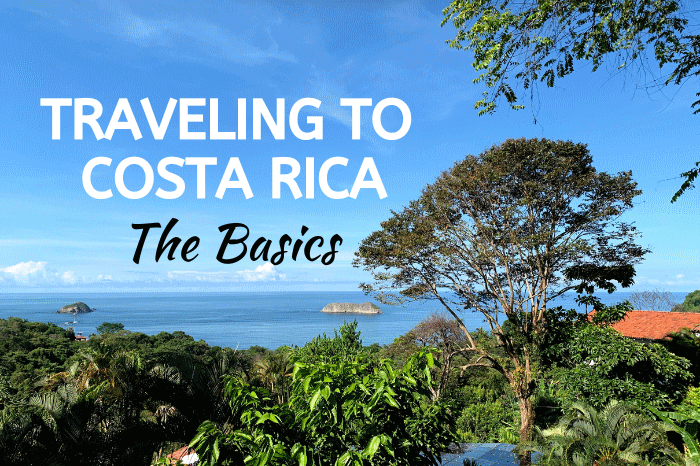
Basic Costa Rica Travel Information
Location
Costa Rica is located in Central America. The Caribbean Sea borders the eastern part of the country. The Pacific Ocean borders the western part and is a much longer section of coastline.
A common misconception is that Costa Rica is an island. This is not true. Nicaragua borders the country to the north and Panama lies to the south.
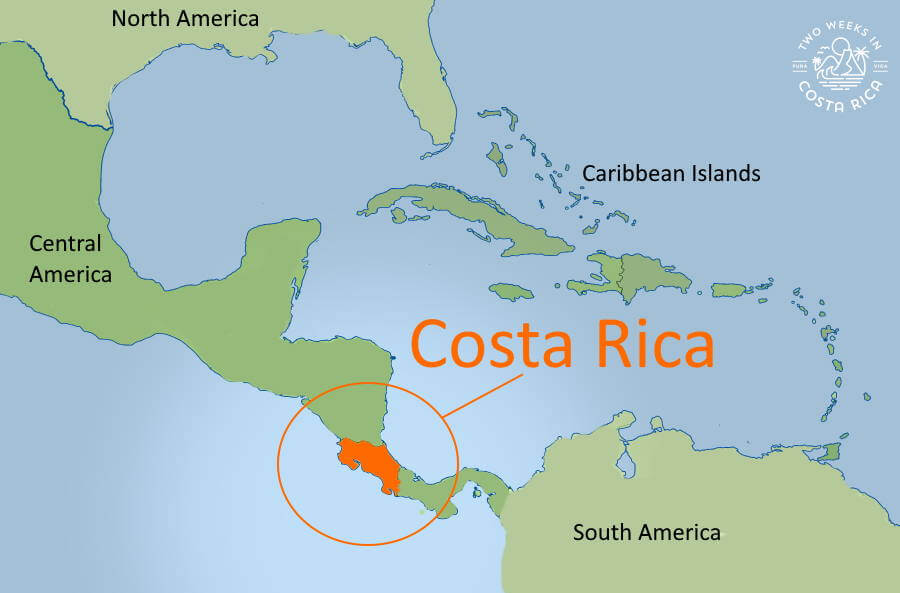
Government
Costa Rica has a democratic government and is considered a peaceful country. In 1949, the country abolished its army and has been without a military ever since.
Airports
The largest airport is Juan Santamaria International Airport (SJO) located in Alajuela near the capital city of San Jose. By world standards, SJO isn’t very big, but it still receives arrivals from around the globe.
The other international airport is Daniel Oduber Quirós International (LIR) in Liberia. This airport is smaller and close to destinations in the region of Guanacaste.
There are also airstrips scattered throughout the country serviced by local small plane carriers.
Entry and Visas
To enter Costa Rica, you need a valid passport and proof of exiting the country within 180 days (e.g., plane ticket).
Visitors from most countries, including the United States, Canada, Australia, New Zealand, and much of Europe, do not need a visa and can stay in the country for up to 180 days.
Visitors from certain countries will need a visa. You can find more information on the Costa Rica Tourism Institute’s website.
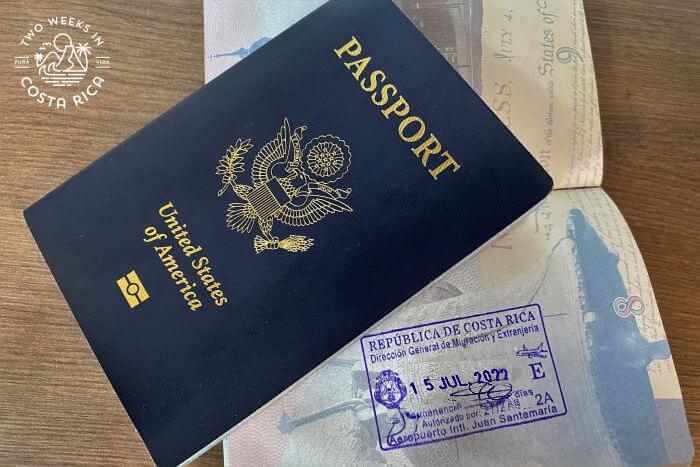
Vaccines
Vaccine Entry Requirements
No vaccines are required to enter Costa Rica except for travelers coming from certain countries in Africa or South America who will need the yellow fever vaccine. Covid vaccination is not required.
It is recommended to be up to date on all routine vaccines to travel to Costa Rica. Here is a link to the US Centers for Disease Control and Prevention website with the list of recommended vaccines.
Language
Spanish is the official language of Costa Rica. English is taught in schools, however, so many people speak at least some basic English.
You don’t need to speak Spanish to visit Costa Rica. People who work in the tourism industry usually speak very good English. Many are fully bilingual. Still, you may find some people who do not speak English.
For a list of useful Spanish phrases for your trip, check out our post, Simple Spanish for Costa Rica.
Climate
Costa Rica is located near the equator so is warm and tropical year-round.
Although small in size, you will find hot and humid rainforest, cool cloud forest, dry tropical forest, wet mangrove, and everything in between.
Costa Rica has two distinct seasons. Dry season runs from around early December to the end of April. Rainy season goes from May to the end of November. The exact timing of when the seasons transition varies geographically. The Caribbean coast has its own unique weather patterns.
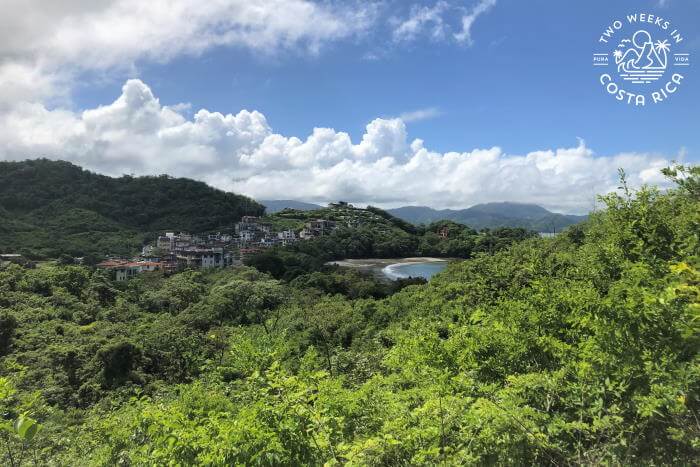
For lots more information on the weather, here are some posts:
Weather in Costa Rica: What You Need to Know
Rainy Season in Costa Rica: How Wet Is It?
Sunset and Sunrise
The sun sets year-round around 5:30 or 5:45 p.m. You can expect full darkness by 6:00 p.m.
Sunrise is between 5:30 and 6:00 a.m. The birds start calling much earlier than that, though!
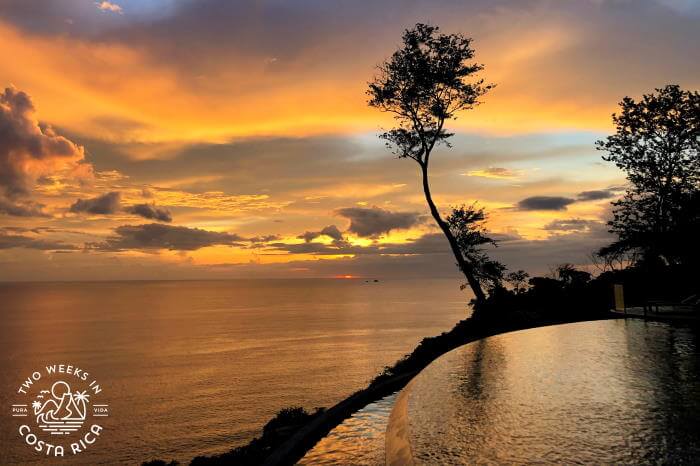
Money
Costa Rica’s currency is the colon, named after Christopher Columbus. There are bills and coins. 600-650 colones equals approximately $1 USD.
US dollars are also accepted. If something is priced in local colones, it is best to pay in colones so that you don’t have to worry about the exchange rate you’re getting.
Hotels and transportation and tour companies often price in US dollars.
You can get colones and US dollars out of the ATM with your debit card. Avoid the money exchange at the airport as it has a poor exchange rate.
You also can bring US dollars but be sure not to have anything larger than a $20 as it may not be accepted.
Some remote destinations like Drake Bay and Tortuguero do not have an ATM machine or bank. Be sure to bring plenty of cash if you’re visiting these areas.
For more tips on money, read our post, Money Matters: Currency, Exchanging Money, and Tipping.
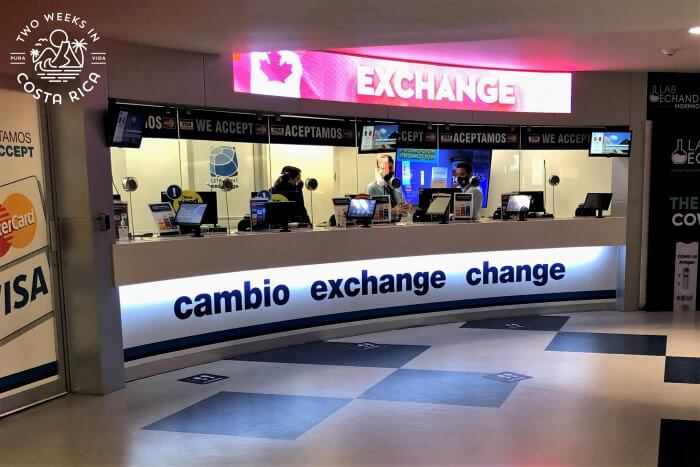
Using Credit Cards
Almost all businesses, even small restaurants, now accept credit cards. Mastercard and Visa are the most commonly accepted.
Having a travel card that doesn’t charge fees for international use is best.
If you’re traveling to a remote destination, be sure to have some cash handy as credit cards are accepted less frequently.
Taxes
A 13% value added tax (VAT) is added to the price of most goods and services.
Tipping
In restaurants, 10% service is added onto the bill. It may be included as a line item or embedded in the prices. Servers do not expect more, but we like to tip extra if the bill was a small amount or the service was good.
Tipping is common for baggage handlers, house keepers, drivers, and tour guides. Our Money post has some guidance on how much to tip.
Drinking Water
The water is safe to drink in most areas of Costa Rica.
Some exceptions where you will likely want filtered or bottled are Esterillos and Bejuco on the central Pacific coast, the southern Nicoya Peninsula (Montezuma and Santa Teresa), the Caribbean coast (Tortuguero, Cahuita, and Puerto Viejo de Talamanca), and parts of Guanacaste (Tamarindo area, Nosara, etc.).
Voltage
Costa Rica uses 120V/60Hz, the same as North America. Electrical outlets are North American style (2 or 3 prong).
Using Your Cell Phone
You can get a local SIM card with a Costa Rica phone number. You just need an unlocked phone (it can’t be tied to another carrier by contract). Phone and internet plans are available from a few different providers and are very affordable. Here is a link to our post, Getting a SIM Card for Travel to Costa Rica, with more information.
Many phone companies in the US and elsewhere also offer international plans on a daily or monthly basis so that you could keep using your regular phone and existing SIM. This is often the easiest option for travelers.
Getting Around Costa Rica
Renting a Car
Many visitors choose to rent a car to get around so that they can explore at their own pace. This is usually the most economical option if you are traveling with four or more people.
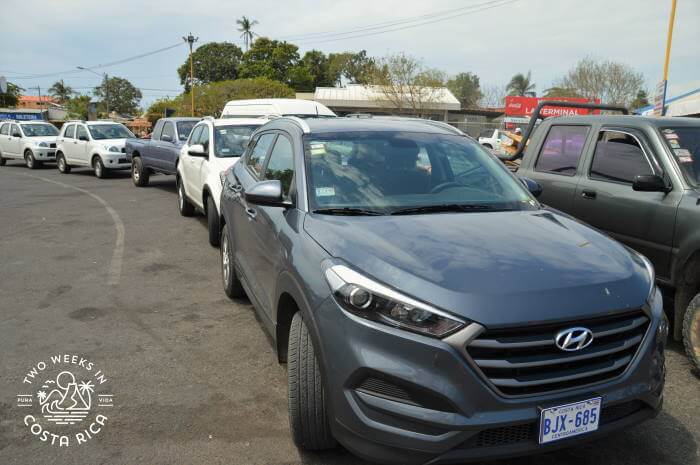
Shuttles
If you are not comfortable driving, shuttle vans are a great alternative. Shared and private shuttles are both options.
Shared shuttles connect major destinations and work on a set schedule. They are less expensive than private shuttles.
Private shuttles can take you anywhere you need to go, pick you up whenever you want, are for your group only, and can make stops along the way.
Check out our post, Taking Shuttles in Costa Rica, for lots more information.
Public Bus
The public bus is the cheapest option and what many locals use. There are two types of public buses: direct and collective. Collective buses stop more frequently.
The public bus goes just about everywhere but usually takes a lot longer than shuttling or driving.
Taxis
Taxis are available in most towns. Official taxis are red with a triangular medallion on the door. Official airport taxis are orange with the triangle. These can be arranged right after you exit the baggage claim.
Be sure they use the meter. Outside San Jose, most taxis don’t have meters so agree on the price before getting in.
Pirate taxis are also common, but we don’t recommend them. These are unofficial taxis that may not have the proper licenses and insurance. They have unmarked cars with regular license plates.
Ride Shares
Uber is available in the San Jose metropolitan area but is not common in other places yet. Keep in mind that Uber can’t pick up right at the airport, so you will need to meet them nearby.
Driving
You do not need an international driver’s license in Costa Rica. Be sure to have your license and passport handy in case you get pulled over by traffic police.
Many people are overwhelmed by the idea of driving in Costa Rica. Overall, the roads are in good condition and paved, especially between common routes connecting tourist destinations.
Costa Rica does have large mountain ranges dividing the country, so some roads are steep with more challenging terrain. Four-wheel drive is recommended for these areas, especially in rainy season.
There are also many side roads that still are not paved.
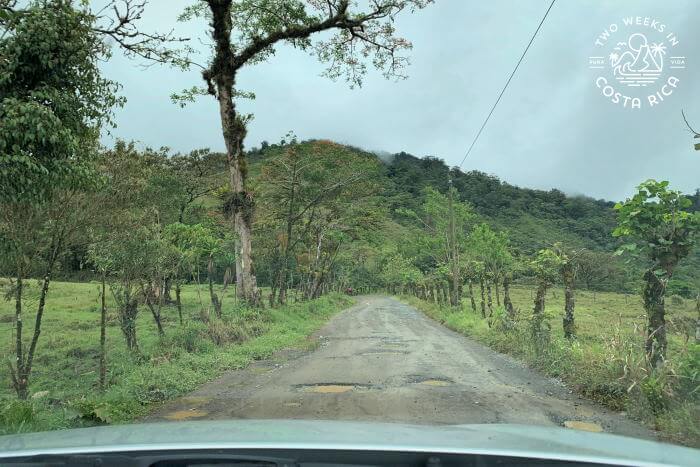
For more specifics about driving and some idiosyncrasies about getting behind the wheel, here are some posts:
Driving in Costa Rica: What to Know Before You Go
Road Conditions of Specific Routes in Costa Rica
Renting a Car
Understanding how insurance works is key to renting a car in Costa Rica.
Costa Rica has a mandatory liability insurance that cannot be declined even if you have coverage of your own. Always be sure this is included when you are looking at prices online. Not all companies include it, and it can be a shock to people when they arrive and find out their rental is going to be $15-20 more per day.
The rental car company that we recommend in Costa Rica is Adobe Rent a Car. They are a local company with offices all around the country. Their cars are never more than two years old. They are transparent with their pricing and include a breakdown of insurance costs in all their quotes. Here’s a link to our Rental Car Discount page where you can save 10% and get free extras like a second driver, surf racks, and car seats for kids.
Most rental car companies will let you decline Car Protection insurance if you can show coverage through your credit card.
For more information on renting a car, check out our post, Renting a Car in Costa Rica: Clearing Up the Confusion.
Crime
Costa Rica is generally very safe as long as you follow the usual precautions. Most crimes against tourists involve petty theft.
Probably the most common crime that tourists encounter is having their rental car broken into. It’s very important not to leave anything inside your car when you park. Backpacks, especially, are often left on the front seat while at the beach, a restaurant, etc.
If you are stopping at a restaurant between destinations, try to park so that you can watch your car. A good practice is to take a small bag with your most valuable belongings with you inside.
Another place to be mindful of security is at the beach. Bring as little with you as you can and take turns swimming so that someone is always with your stuff.
Here’s a link to our Safety Tips post with more information.
If you’re planning to stay in an Airbnb, be sure to check out our post, Vacation Rentals in Costa Rica: Safety and What to Look for.
Medical Care
Costa Rica has socialized medical care. Public hospitals and clinics are located all around the country and provide fairly good care.
Most popular tourist destinations have private clinics with English-speaking doctors. These are a great resource in case of emergency. The cost for care is very affordable, at around $65-100 for most minor incidents/illnesses.
Modern private hospitals are available in San Jose. Some good ones include Hospital CIMA, Clinica Biblica, and Hospital Metropolitano.
Travel Insurance
It’s a good idea to purchase travel insurance for your trip so that you’re covered in case of emergency. Usually your medical insurance from home won’t cover you abroad.
There are many insurance companies to choose from. One reputable option that we have used ourselves is Travelex. They have plans that cover trip cancellation, interruption, and delays as well as emergency medical, evacuation services, and Covid-19.
For more information on travel insurance, check out our post, Why to Get Travel Insurance When Visiting Costa Rica.
*Note: If you purchase a Travelex insurance policy through the link above, we earn a small commission at no additional cost to you. This helps support our site and allows us to keep this information up to date. Thank you!

Mosquito-Borne Illnesses
Dengue is the most common illness you can get from a mosquito, but it is still not that prevalent. Malaria is present in Costa Rica but uncommon.
Mosquitoes are the most abundant during rainy season (May through November) but can be found year-round in most places.
The best precaution you can take against getting a mosquito illness is to avoid bites by wearing repellent or covering up. For specific tips, read our post, Mosquitoes in Costa Rica: Tips to Prevent Zika, Dengue, and More.
If you are prone to bites, you may want to avoid accommodations that are open to the outdoors. Instead, opt for a hotel room that closes up completely with screens on the windows, etc.
Conclusion
We hope this post gave you some general background about Costa Rica travel. If we’ve left something out and you have a question, feel free to ask in the comments below.
Pin It for Later

Last Updated: October 21, 2024
Looking for more information to help plan your Costa Rica vacation? Check out these posts:
First-Time Visit to Costa Rica: Information on why you should go, what to expect, and more tips to plan.
Itineraries: Check out our Itineraries page for sample itineraries for one- and two-week visits, family vacations, and rainy season travel.
Destinations Summary Guide: Get a quick snapshot of Costa Rica’s popular (and lesser known) destinations with links to more information.
